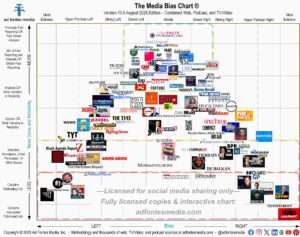
Transforming Media Literacy Education with the Power of the Media Bias Chart
Author:
Jennifer Arvin Furlong
Date:
12/06/2023
I recently had the privilege of attending the 103rd annual conference for the National Council for the Social Studies, an event that brought together thousands of dedicated social studies educators, administrators, and professionals from around the nation. As the communications director for Ad Fontes Media, I was honored to have the opportunity to have conversations with passionate teachers who are committed to delivering meaningful and engaging content to their students.
One key highlight of our discussions was centered around media literacy education, a critical component in today’s information-rich world. Many educators I met were familiar with the Media Bias Chart®, a powerful tool created by Ad Fontes Media to teach news literacy. However, it was surprising to discover that a significant number of teachers were not aware of the interactive version of the Media Bias Chart, an invaluable resource for dynamic and immersive learning experiences.
The Interactive Media Bias Chart (IMBC) takes the traditional static charts to a whole new level, providing an engaging platform for educators to have deeper discussions on media bias and reliability. Teachers expressed excitement about the versatility of this tool and discussed various ways to integrate it into their courses, spanning government and civics, history, current events, geography, and economics.
For those yet to discover the IMBC, it offers an immersive experience, allowing users to explore and interact with real-time information. It becomes a living resource that evolves alongside the ever-changing media landscape, ensuring that educators can offer their students the most up-to-date insights.
To further support teachers in their mission to foster media literacy, Ad Fontes Media offers instructor resources through subscription services. The Classroom Premium and Campus Pro editions provide access to valuable tools, including an Instructor Resource Manual, a Starter Lesson Plan, Intermediate Lesson Plan, and an Advanced Lesson Plan. These resources empower educators to seamlessly integrate media literacy education into their curriculum.
One key advantage of utilizing the Media Bias Chart in the classroom is its nonpartisan nature. Ad Fontes Media (AFM) analysts represent the political spectrum from left to right, ensuring a balanced perspective. Additionally, AFM’s methodology equips teachers to address student and parent concerns about bias in media consumption, promoting a more nuanced understanding of information sources.
Media literacy education is more crucial than ever in a world inundated with information. Educators play a pivotal role in shaping the next generation’s ability to critically analyze and navigate the media landscape. By subscribing to the Interactive Media Bias Chart, teachers not only enhance their own understanding but also empower students to become discerning consumers of information.
We encourage teachers to advocate for media literacy education in K-12 and invite parents to support this initiative. Suggesting the use of the Media Bias Chart in classrooms can be a proactive step toward cultivating a generation of informed and critically thinking citizens. Together, we can bridge the gap between information and understanding, empowering students to navigate the complexities of the modern media landscape with confidence and competence
If you are curious about how to use the chart as a tool in the classroom to teach media literacy, contact me at jennifer@adfontesmedia.com for a free demonstration.
And if you want to attend our next free webinar on “Teaching News Literacy in the Era of Hyper-Polarized Media” as well as keep up on all of the important work being done by Ad Fontes Media, subscribe to our free weekly email newsletter!


